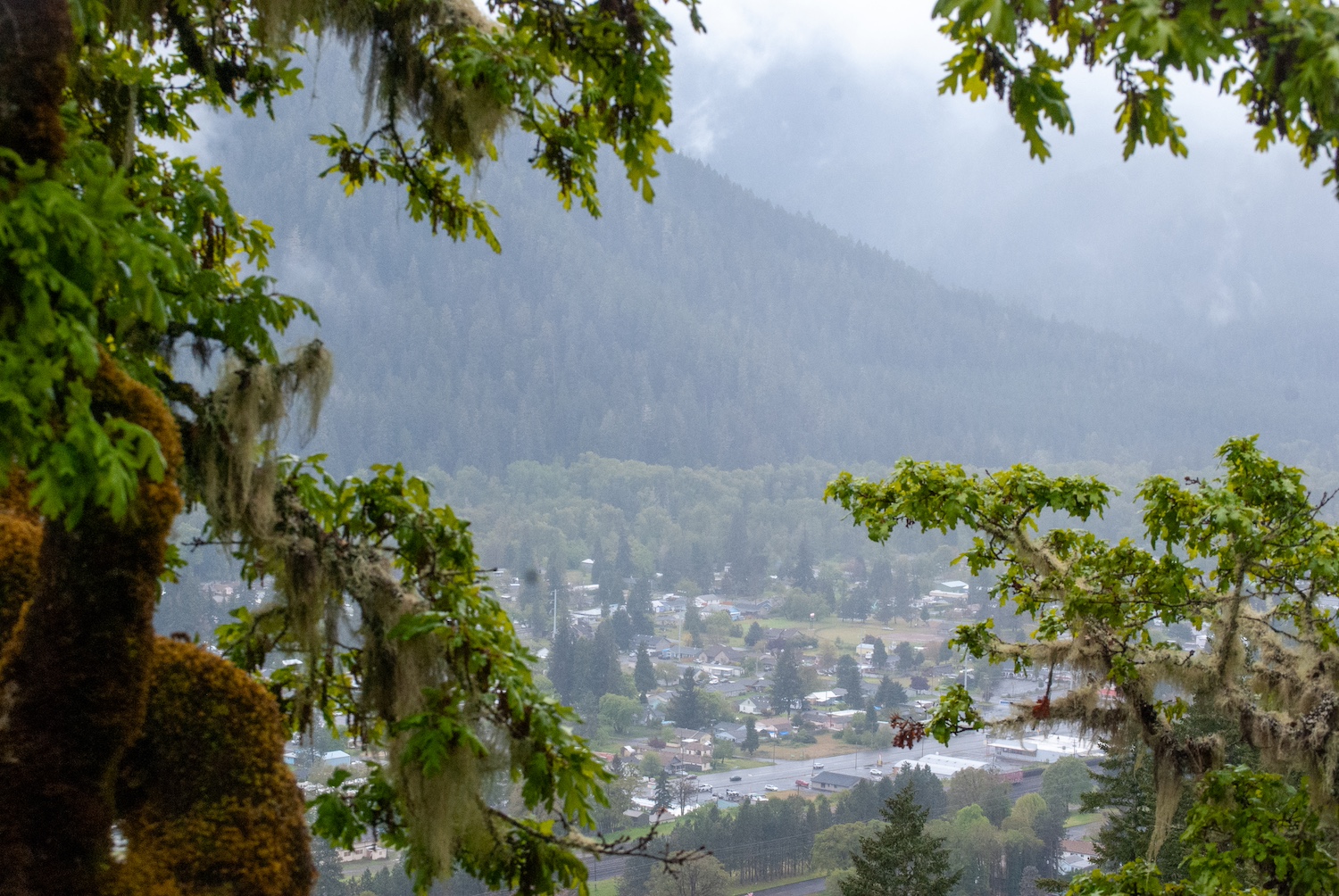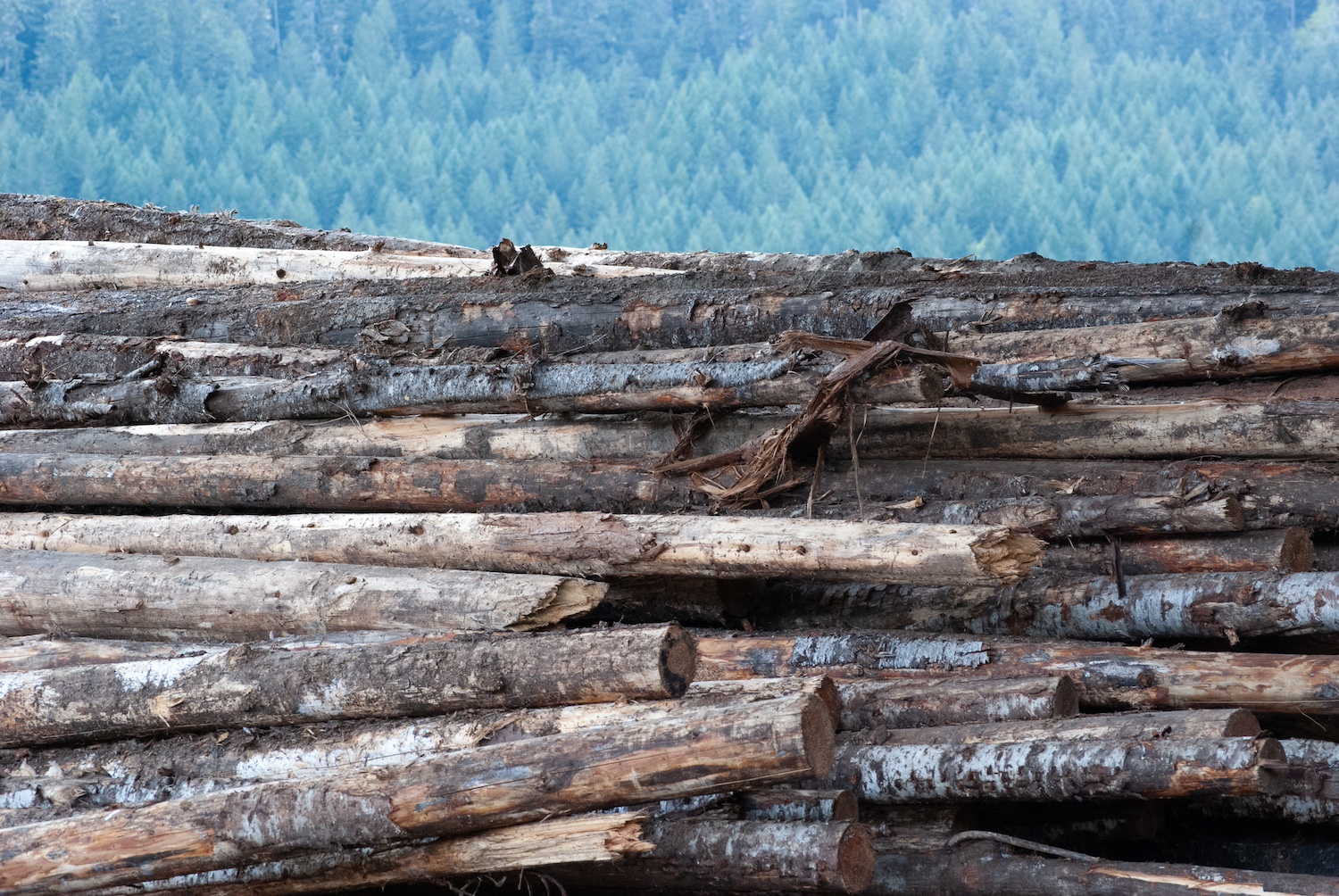
Trees left with burn scars years after a wildfire in Oregon's Cascade Mountain Range. (Image: Ashli Blow)
Driving down a gravel mountain road, Brock Buchmeier hauls a truckload of wood salvaged largely from forest fires. He brings a mixture of felled trees like cedar, oak and fir to an industrial park in Oakridge, Oregon, a small city just above the snow line.
“It’s a sketchy job, but someone has to do it,” Buchmeier said. “I’m doing anywhere between three to four trips a day to get this wood to the lot.”
His business, Brock’s Wood Lot, is the first in an emerging regional forest resource hub that could revolutionize how leftover debris from wildfires and logging are processed in this once-booming timber town.
The lot is one of 171 projects funded in part by a U.S. Department of Agriculture wood innovation grant program that creates new markets in rural communities while trying to manage wildfire risks. These nationwide projects share similarities, but each comes with its own set of challenges unique to the region.
For Oakridge, a smokey problem lies within its basin-shaped valley that traps pollutants in the air. Buchmeier and community partners are trying to solve it while living with wildfires.

Using the unusable
This August, the Willamette Complex Fire, composed of several wildfires, burns outside of Oakridge. Its smoke brings high concentrations of particulate matter that can linger for months. And the residents there won’t have much of a reprieve come winter when more smoke follows from wood stoves, as most use them as their primary heat source.
It’s been a public health issue for years. So in response, the community started with their own homes.
But their transition to cleaner energy couldn’t exclusively turn to electric solutions like heat pumps. People in Oakridge tried it, installing free heat pumps from weatherization-adjacent programs. They became unreliable for a forest community with vulnerable infrastructure.
“After several years of living through power outages and not having heat for their homes, they took them out and went back to wood stoves,” said Sarah Altemus-Pope, executive director of the Southern Willamette Forest Collaborative. The group facilitates community-led decisions and secures funding for its plans by working with government departments, including the United States Environmental Protection Agency (EPA).
“If we were going to ask the EPA to invest millions in this community to upgrade wood stoves, then we really had to argue with the EPA, ‘Let us build a program that is going to guarantee dry wood,’ because that’s a missing piece,” she said.

For fuel, people burned wet wood, which produces denser and more toxic smoke than burning dry wood. But their options were limited. Cutting restrictions kept them from collecting wood in forests, and they didn’t have a vendor to buy from. They turned to buying wood out of the back of people’s trucks, where Buchmeier once sold his own bundles.
“It seemed that we could never cut enough wood,” he said. “There’s always a demand for firewood. So I bumped into Sarah, who said, ‘There’s this opportunity for a community firewood program.’ And I put one foot in front of the other.”
Altemus-Pope, who worked as a wildland firefighter, wanted to take it a step further. Not only could the program address wet wood, it could also reduce the woody debris that make fires burn exceptionally large and hot.
In the neighboring forests, bonfire-like piles of debris were stacking up. Some of this came from wildfire crews cutting trees to safely access and put out fires, while some came from loggers sorting through the unprofitable pieces of their harvest.
The forest service usually burns these piles under federal guidelines, but the process was another smoke source. So, Altemus-Pope and Buchmeier partnered with their local district to salvage them. After securing grants through the EPA, the U.S. Department of Agriculture, and local conservation districts, they acquired the equipment they needed to get started.

Doubling down
After trucking loads of treetops, branches and other vegetation from the forest to his lot, Buchmeier sorts them by species and moisture content. He then methodically dries them in a kiln powered by lower-quality wood from the piles.
In the last year, the community firewood program collected 200 cords, an industry measurement for stacks of wood that measure four feet high and four feet wide. It plans to double that this year with two new employees to help with the workload.

The goal is for the lot to be a launchpad for a wood resource hub that supports multiple businesses in one location, creating diverse products — from firewood to biochar — while sharing costs and materials. Right now, the margins for the wood lot are slim.
“I get calls all the time about, ‘Hey, we want to create a community partner program like yours,’" Altemus-Pope said. “It’s just not something anyone can do … It’s really expensive.”
The cost of operation is twice as much as what’s earned selling the firewood to city-subsidized buyers — a large portion of their customers who have low incomes, have a disability or are over 65 years old. To help cover the program costs, Buchmeier expanded to commercial sales, supplying firewood to hundreds of campgrounds throughout the Pacific Northwest.
But the business' primary focus is community service, not its bottom line.
“That’s what’s unique about this community, but I do think these lessons learned can be absolutely translated to other and bigger communities,” said Altemus-Pope, referring to leveraging the intersection of grants and natural resources.
Recently, millions of dollars were funneled from the federal wood innovation grant program to support wood processing facilities at the heart of small rural towns, including Buchmeier’s business. Wood processing was at the center of Oakridge for decades until its last timber mill closed in the 1980s. Reversing the economic damage doesn’t just take community innovation, it takes money.
“These investments will support good paying jobs for families and communities,” Xochitl Torres Small, U.S. deputy secretary of agriculture, said in a statement. “It will increase the economy’s capacity to manufacture wood products. In turn, sustainably sourcing the wood used to manufacture these products will make our forests healthier and reduce the threat of catastrophic wildfires.”
That’s what is starting to happen at the Oakridge community firewood lot, one truckload at a time.
Reporting for this story was made possible with a fellowship from the nonprofit Institute for Journalism and Natural Resources.

Ashli Blow is an independent journalist and researcher specializing in environmental science, policy and justice. Her work centers on solutions-oriented journalism and projects, with a particular focus on climate adaptation, pollution abatement and wildland fire management. She holds a Master of Public Administration in Environmental Policy.













